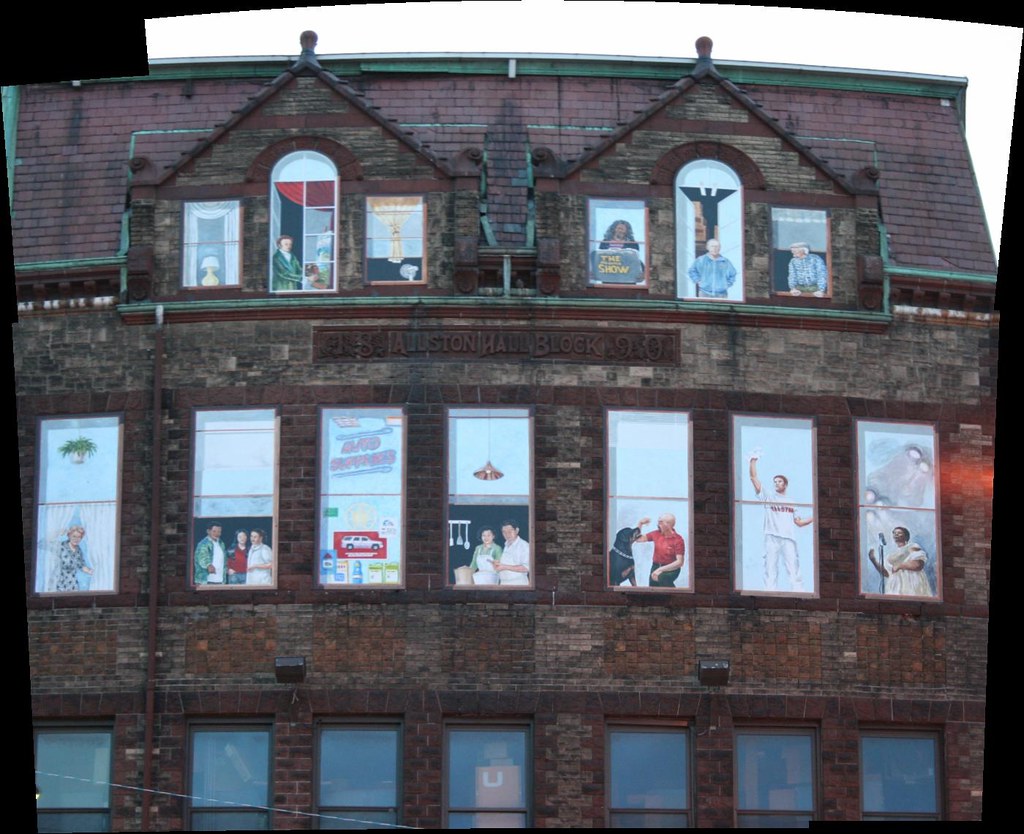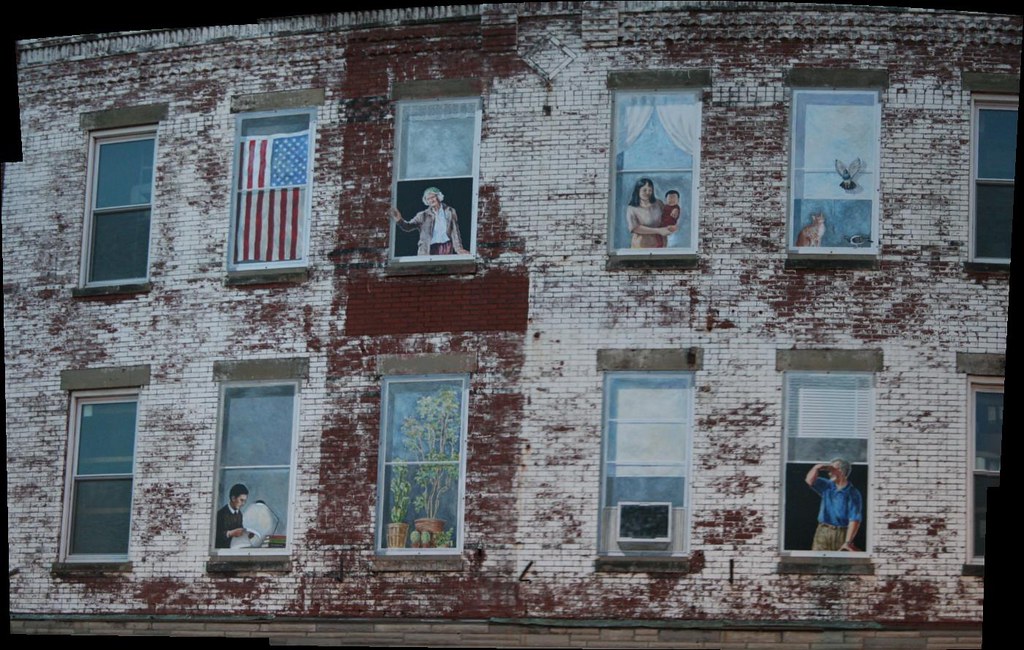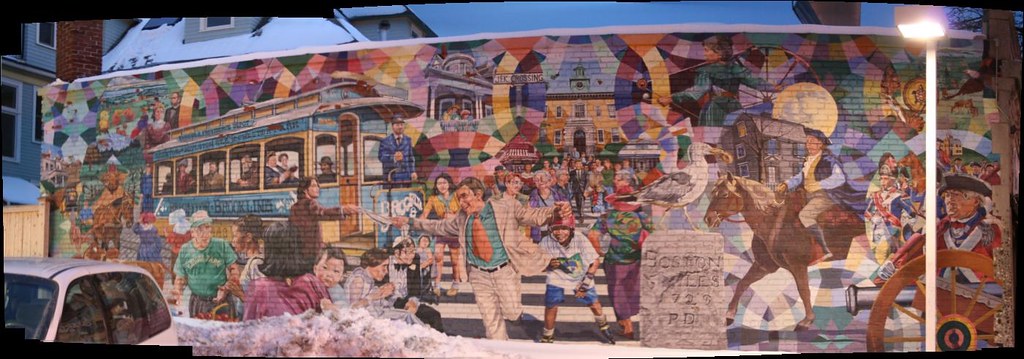You can take a virtual tour. We can see the description of the murals by the artist himself. The title of the murals are 'Triumph of Religion.' The artist had worked on this project from 1895 to 1916. This project in Boston Public Library is John Singer Sargent's first mural project. We can see his other work in Museum of Fine Art in Boston.
| Route & Maps Generator |
There are several types of murals: public murals, commercial murals, and murals in residence houses. For some public murals, the communities surrounding them are deeply involved.
There are some murals I am impressed:
===Central Square parking lot around Harvest (a co-op grocery store)===
| - map-generator.net - |

Potluck, painted by David Fichter in 1994.
From central square in Cambridge to Inman square in Somerville, there are people from different countries with different cultures. We can see these people in the mural, and they are happily sharing the food, chatting, and dancing. There are more details in David's website.
| Route & Maps Generator |

Since it is on the wall of Harvest co-op grocery store, I assume the 'precautionary principle' is Harvest's principle. We can see there are animals with their cubs, some children, and a mother with her child.
===Central square around Blockbuster===
| Language Translations |

A Celebration of Imagination, a Tribute to Marc Chagall, painted by Pasqualina Azzarello in 1997.
Because this mural is a tribute to Marc Chagall, we can see the painter chose some colors and lines similar to what are seen in Chagall's paintings.
===Central square on the wall of Middle East restaurant and night club===
| - map-generator.net - |

Because Middle East is a restaurant and a night club, we can see people in the mural are playing different musical instruments. In addition, it contains a lot of oriental flavor.
===S&S restaurant in Cambridge===
| Route & Maps Generator |
The mural can be seen here. The artist is Joshua Winer. This restaurant has great brunch!
===Harvard square theater (of course, around Harvard square)===
| English German Translation |
The mural can be seen here. The artist is also Joshua Winer.
===Trader Joe (a grocery store) in Cambridge===
| - map-generator.net - |
Sunday Afternoon on the Charles River, painted by David Fichter in 2005. We can see in the mural, people enjoy the picnic besides the river. There is Harvard bridge, and people are kayaking and canoing. In the left side, we can see the old Harvard square with the trolley—now there is underground subway (red line). In the right side, there is a woman hold a Trader Joe's bag. But beyond her, there is the the main dome at MIT. In the summer time, Harvard blocks part of Memorial Drive for people to enjoy their Sunday.
===Inside Science Museum===
| by English Translations |
This muralt was painted by Amy Barlett Wright. Her environment-oriented style is very different from the energetic style in the murals around central square.
===Allson===
| by English Translations |


There are many asian, indian, and russian people in this area as far as I know (from the restaurants). I did not find any information about this mural.
===JFK crossing===
| - map-generator.net - |

This mural was painted by David Fichter in 1995. I guess the man in the center of the mural is JFK. This area in Brookline is where Kennedy was born, and the locals call it 'JFK crossing.' They said there are four murals, but I only remember three: this one, another one across the street, and the other one one block away.
===Zaftigs restaurant around Coolidge corner===
| by English Translations |

Coolidge corner is full of Jewish culture—there are Jewish bookstores, Jewish restaurants, and etc. Of course Zaftigs restaurant is a Jewish restaurant. In the center of the mural, I think it is the historic building in the center of Coolidge corner. In the left part, we can see the Coolidge corner theater and the trolley (green line). About the women in red dress, I guess she was the owner of Zaftigs because there is a portrait similar to these women in the restaurant.
===Newberry Street===
Newberry street is a famous shopping area in Boston, and this mural is a very famous one on Newberry street. They said there are more than 50 famous people, including JFK, Babe Ruth, Bette Davis and Isabella Stewart Gardner. It is painted by Joshua Winer in 1991.
===Downtown===
| - map-generator.net - |
This mosaic mural is outside the Grand Lodge of Masons in Mass. It contains three panels: Greek Doric column, the motto of Massachusetts Freemasons, a plumb, and something I am not sure what it is about.
===Chinatown===
| Misterinfo |
Many people take photo of this mural because it is on the wall facing the popular parking log. Although the Buddha in the center attracts our attention, this mural is about anti-smoking. It was painted by Boston Youth Fund Mural Crew in 1998.
| English German Translation |
This mural is outside the Chinese community center. I guess the man on the top is about the business of laundry. There are other people in this mural tailoring, cooking, working in a construction site, transporting merchandise, rowing a dragon boat (right upper part), telling stories, learning English, striking, planting. I guess because it is very close to the New England Medical Center, there is a physician in this mural.
This mural was painted by David Fichter in 1986.
| - map-generator.net - |
There is another mural painted by Boston Youth Fund Mural Crew. It was painted in 1997. It is around the Chinatown gate. We can see many characters in famous Chinese stories.
Because the involvement of the community or the local stores, I found where there is a mural, there are many interesting local stores and interesting community activities.